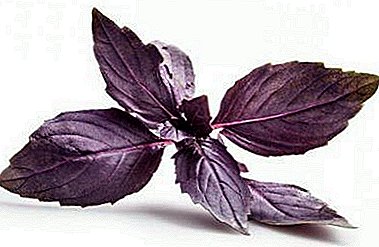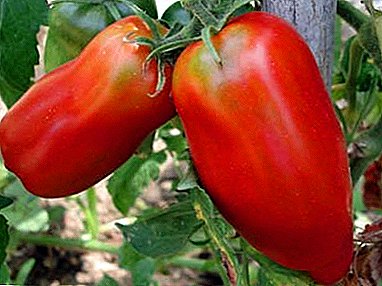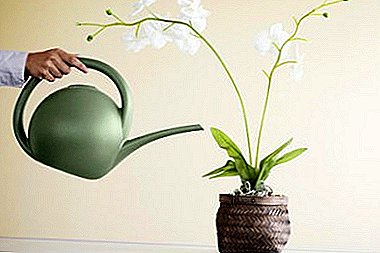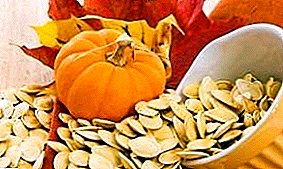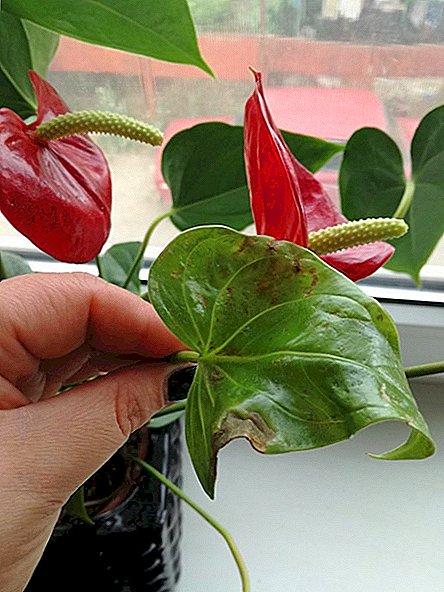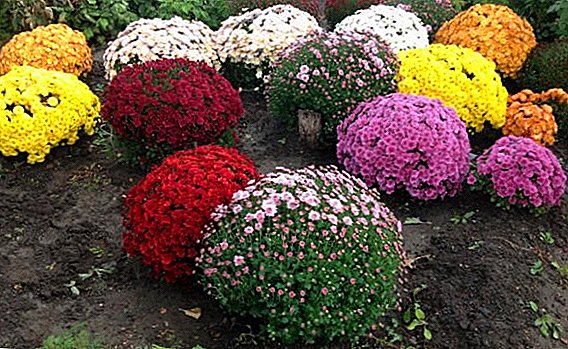 The end of the vegetative period was always marked for plants and flowers by the transition to wintering, a kind of hibernation, during which renewed vitality and self-preservation occurs. Wintering is very important for the full growth and development of plants and flowers, and therefore it is important to carefully and carefully treat this, in every way facilitating the systematic transfer of the representative of the flora into hibernation, so that at the end of this period it will open again in all its glory, filled with strength and ready to please the eye new period of violent bloom. We will talk about how to store chrysanthemum multiflora in our article.
The end of the vegetative period was always marked for plants and flowers by the transition to wintering, a kind of hibernation, during which renewed vitality and self-preservation occurs. Wintering is very important for the full growth and development of plants and flowers, and therefore it is important to carefully and carefully treat this, in every way facilitating the systematic transfer of the representative of the flora into hibernation, so that at the end of this period it will open again in all its glory, filled with strength and ready to please the eye new period of violent bloom. We will talk about how to store chrysanthemum multiflora in our article.
Rules for preparing the plant for wintering
Help in the transition to the plant during the wintering period is an integral part of the autumn work of each gardener. And in the case of chrysanthemums, this rule also has a place to be. From the very beginning of the growing season, you must carefully track the slightest manifestations of painful lesions on the shoots, leaves and flowers of the plant.  If such ailments were discovered, then it is necessary to deal with them as quickly as possible, completely eliminating the defeat and preventing it from further spreading through the flower outlet. But especially careful pest control requires a plant during the onset of autumn and preparation for a long winter. It is very important to preserve the healthy state of the whole plant in order to prevent the progression of the disease throughout the winter, because it may depend on the fact that your chrysanthemum will overwinter or die.
If such ailments were discovered, then it is necessary to deal with them as quickly as possible, completely eliminating the defeat and preventing it from further spreading through the flower outlet. But especially careful pest control requires a plant during the onset of autumn and preparation for a long winter. It is very important to preserve the healthy state of the whole plant in order to prevent the progression of the disease throughout the winter, because it may depend on the fact that your chrysanthemum will overwinter or die.
Highlights are also important. watering and fertilizer. During the spring and summer, you must properly water the chrysanthemum.
Did you know? Chrysanthemum is a national symbol of Japan. In this country, there is even the highest award - the Order of Chrysanthemums.
Concerning top dressing, then in the spring you need to make nitrogen fertilizers, which will contribute to active growth and flowering, but in the fall it can not be done. In the autumn, chrysanthemum should be fed with potash and phosphate fertilizers, which will maintain its healthy and strong appearance, as well as protect it from freezing and death during the cold season.  After the coming of the first serious cold chrysanthemum can cut off old, dead or dried shoots.
After the coming of the first serious cold chrysanthemum can cut off old, dead or dried shoots.
Important! It is worthwhile to carry out measures for pruning chrysanthemums as late as possible so that the juice from all processes, even those dying, goes into the trunk. So you protect your representative flora from unwanted loss of water and, consequently, death in winter.
At the same time, conduct a final inspection of the plant for rotten or mold damage. If they are found, they do not need to stand on ceremony, but carefully clean everything up to prevent further infection.
In addition, should shorten the main, strong shoots to 10-15 cm, while, as a rule, the young processes do not touch.
Chrysanthemum multiflora - a line of small-colored undersized chrysanthemums with lush, thick and abundant flowering. This group has the genetic form of a ball, for which it is also called spherical chrysanthemum. Chrysanthemum multiflora is not a moody flower, the rules for planting and caring for it are quite simple.
How to keep chrysanthemums in the winter, not digging
First we consider the storage method without first digging it out. This method is a bit simpler than additional transplants and possible injuries to plants, but it also has a number of nuances, which we will discuss later. 
Chrysanthemum shelter for the winter
This option is recommended only if if your region has mild winters, not accompanied by sharp changes in temperature.
For this, the bushes previously checked and treated for all pests and diseases, are cut to 10–15 cm, after which the substrate is richly spud from all sides. It is important here that the pits and depressions do not form around the bush, where excess moisture will subsequently accumulate. This should be done when the thermometer will be stable at or near 0 ° C, otherwise chrysanthemums may melt before the cold comes.
We advise you to read about the proper preparation and wintering of dahlias, gladioli, lilies, roses, hydrangeas.
In colder regions, one land will not be enough, and therefore it will be necessary to lay chrysanthemum bushes on top with additional layers of thermal shading.
After the onset of constant frosts, should be plentifully cover the area with these plants a thick layer of dry leaves or pine spruce branches. This layer of thermal insulation will also perfectly keep your pets from the cold. When the snow falls, on the leaves you can throw a high drifts, which will also be excellent thermal insulation.  The only drawback of this method is that you can not control the condition of the plants under all these layers.
The only drawback of this method is that you can not control the condition of the plants under all these layers.
Familiarize yourself with the varieties of chrysanthemums and the basics of their cultivation: Indian, Korean (varieties, care).
Trench storage
If you live in a region where soils do not freeze over much, and snow falls heavily in winterthen this method of dropping in the trenches will be optimal for you. Where the chrysanthemum was prikopan, in the spring you need to first remove the snow and keep this place dry.
By itself, the prikop is a kind of ditch, the depth of which can vary from 0.5 to 1 m.
Important! It is also recommended to dig a trench no wider than a spade bayonet (about 20-30 cm), because the flowers will be better preserved.
Prepared and processed chrysanthemums are laid on the bottom of the pit so that they are located as close as possible to each other. It is also allowed with a large number of these representatives of the flora to put them in two layers. The rest of the place in the trench is filled with a very loose substrate, and then covered with leaves and spruce branches.
Inside such a trench should be as dry as possible, because high humidity will become the main enemy of the shrub.  After the leaves and spruce leaves such a shelter is covered with boards and roofing felt, then a film goes into the business, which is fixed at the edges with the help of earth or heavy weights. It is also recommended to pile leaves on top of the film, and when snow falls, roll a snowdrift.
After the leaves and spruce leaves such a shelter is covered with boards and roofing felt, then a film goes into the business, which is fixed at the edges with the help of earth or heavy weights. It is also recommended to pile leaves on top of the film, and when snow falls, roll a snowdrift.
When spring comes, this shelter should be disassembled smoothly, in layers. So you will save your chrysanthemum from damage and temperature extremes. At the first thaws begin to disassemble the shelter, every day removing one layer.
Varietal variety of chrysanthemums is very large. Familiarize yourself with the types and varieties of garden chrysanthemums, chrysanthemums-pyszhestvetov.
How to keep multiflora indoors
In addition to preserving chrysanthemum without first digging on the ground, there is a second method that is different from the previous one. So, chrysanthemum, dug out with a root and a clod of earth, can be stored in a cellar, pot, or greenhouse. We will talk about all these storage methods further.
In the cellar
The success of this method of storage will largely depend on how well the flower has been pre-prepared for the frosty period, whether the rules for digging up the root system have been observed, and on the conditions created in the basement.  As for the last of the requirements, before sending chrysanthemums to a deserved rest in the cellar, you should comply with the following prescribed requirements:
As for the last of the requirements, before sending chrysanthemums to a deserved rest in the cellar, you should comply with the following prescribed requirements:
- the cellar should be maintained at a constant low temperature, whose figure should vary in the range from 0 to +4 ° С;
- it is necessary to provide the air with a proper concentration of humidity (good, in the basements the humidity is usually high);
- in addition, it is important to provide air ventilation, but at the same time avoid drafts;
- need to take care of sanitary sterility of the room: remove the fungus, mold, rodents, insects, etc.
Only by taking into account and fulfilling these conditions, you can load flowers into the cellar.
Read also about the construction of the cellar in the country and ventilation equipment in the cellar.
Recommended place the roots directly on the cellar floor or in a separate special container, having put them in beforehand with a 5 cm layer of earth. Plant bushes should be placed as closely as possible to each other so that they do not freeze. Above the rhizomes, it is recommended to pour the substrate for additional protection from frost. From the ground, the roots will take everything you need for a successful wintering.
After loading the plants in the cellar, they no longer need constant care. All that is required of you is to periodically (approximately once a month) inspect for mold / putrefactive lesions or dry roots.  If mold or rot is detected, the damaged plant should be removed immediately from the cellar, and the rest treated with antiseptic agents. If you see that the roots are too dry, then spray the ground with water so that it becomes well hydrated, but do not overdo it.
If mold or rot is detected, the damaged plant should be removed immediately from the cellar, and the rest treated with antiseptic agents. If you see that the roots are too dry, then spray the ground with water so that it becomes well hydrated, but do not overdo it.
You can also add that the preservation of chrysanthemums in the basement is the most common and widely used method.
Important! Sometimes there are situations when the temperature in the cellar rises so much that the flowers of chrysanthemums begin to wake up from hibernation and throw out new shoots. At the same time, the latter are too weak and sluggish. They will only spend the power of the flower, and therefore such a nuisance should be stopped in time, having arranged additional airing. Carefully monitor compliance with the correct temperature, to keep the data of representatives of the flora in a healthy way.
In a pot
Another frequently used method for storing chrysanthemums in the winter is pots that take them to a warm place.  You can transport the chrysanthemum from the garden to the flower pot using the following guidelines:
You can transport the chrysanthemum from the garden to the flower pot using the following guidelines:
- You need to dig a bush that is still blooming. Properly dig up it will help you pre-abundant watering the soil around the plant. So you will not damage the root system.
- Due to the fact that chrysanthemums have a rather massive root system, it is worthwhile to prepare a large pot for them.
- The bottom of the flower pot should be densely covered with a layer of drainage, which is recommended to use expanded clay, gravel, broken brick or other material. It is important to take into account the peculiarity that multiflora does not like excessive dampness, so do not regret the drainage.
- Having placed the chrysanthemum in a pot, you need to fill the cavities with fresh crumbly substrate. Remember that you do not need to plant too deep a flower. Use the same depth to which he was planted in the garden.
- While the chrysanthemum is in bloom, it should be maintained as a normal house plant: on the windowsill, with a sufficient abundance of light and heat.
- After completion of flowering, multiflora is generously cut to 10-15 cm.
- It can then be transferred to a dark and cool storage place throughout the winter. Such a place can act cellar or basement.
- As in the previous method, here it is necessary to carefully monitor the level of temperature and humidity, as well as inspect the shoots for mold or putrefaction.
- In spring, when the active growth of the flower begins, it should be transplanted into the garden. But do not rush until the weather settles on a stable warm mode.
Learn more about growing room chrysanthemums: planting and care, what to do if a room chrysanthemum has blossomed.
Video: chrysanthemum multiflora wintering in a pot
In the greenhouse
The third method of winter storage of data of flora representatives is greenhouse. Even during the active flowering bushes are transplanted under the cover of the greenhouse, which significantly prolongs the budding period.
You can build a greenhouse on the site with your own hands from wood, plastic pipes, polycarbonate; with opening roof.
At that moment, when outside will be dominated by freezing temperatures, and the stalks of your pets begin to freeze, you should produce large pruning, leaving only low (3-4 cm) hemp. After this procedure, hemp generously covered with a layer of humus, which will save the root system from death in severe frosts.
For even greater thermal insulation, the bushes need to additionally fall asleep dry substrate, covering the hemp at 20-25 cm.
Important! Make sure that the land layer is completely dry, because excessive dampness for chrysanthemums in the winter time will be detrimental, as mold and putrefaction processes begin, which you will not see because of the thermal insulation of the land layer. In order not to detect the rotten remains in the spring, do not neglect this rule!
Next, the ground is covered multiple layers of thermal capping. Such a puff "cake" of thermally insulating materials will protect the chrysanthemum from frost in the greenhouse.
In addition to the foregoing, this method is another difficulty. In the spring you need time to podgadat moment to unearth the multiflora, otherwise it will die from vypryvaniya. As soon as the thermometer will be steadily in a positive position, boldly dig up your flora representatives. And in a couple of weeks they can be returned to the garden. If you have a heated greenhouse, and the temperature in it does not fall below 0 ° C and does not rise above +5 ° C, then in this case it is not necessary to cover the bushes with anything. They will remain excellent in clear form.
Did you know? Chrysanthemums are well tolerated transplant at any time of the year, unlike many of their blossoming relatives.
Video: storing chrysanthemum multiflora in a greenhouse
How to dig chrysanthemums correctly: precautions
In addition to proper storage in the winter, chrysanthemum bushes must be very carefully removed from the ground to keep the root system safe and sound. If this manipulation is not successful, the risk of various diseases or even the death of the plant will increase several times. To prevent this, you should follow certain rules and precautions when removing a flower from the ground. It is recommended to do this operation in late autumn.
- Liberally moisten the place of digging with water so that the earth does not crumble and expose the roots of the plant. So you can protect them from unnecessary injury.
- Do not shake the ground, and try to keep the ball in its original form.
- Leave the chrysanthemum to dry for a couple of days outdoors to rid the rhizome of excessive moisture. If damage or attack by insects is detected, it is necessary to immediately clean up and treat the affected areas with appropriate preparations.
Observing these rules, you can safely send your chrysanthemum from the garden to the place of wintering.
Read also about the reproduction of chrysanthemum seeds and cuttings, as well as transplanting in the fall and spring.
Video: digging chrysanthemum multiflora
Winter storage experience of chrysanthemum multiflora: reviews
Tatisha
All the multiflorks were wintered with me. Recently, the thought began to creep in my mind that under spunbond and other shelters, chrysanthemums overwinter worse than if you just cut and toss the badillae from above. So far, not one of the badillas that I sheltered has died in the winter, but the couple, whom they arranged for in the fall, didn’t spend the winter dancing with a tambourine. It may of course be a coincidence.


Preparing a garden for wintering is a very important moment for any gardener. After all, it depends on your actions or inaction whether the flowers survive the winter and whether they will be able to start the vegetative process anew, delighting those around you with abundant flowering. Based on our instructions and guided by the above tips, you keep your pets in a healthy and strong form.


